FREE Standard Shipping On All Orders $100 or More!*
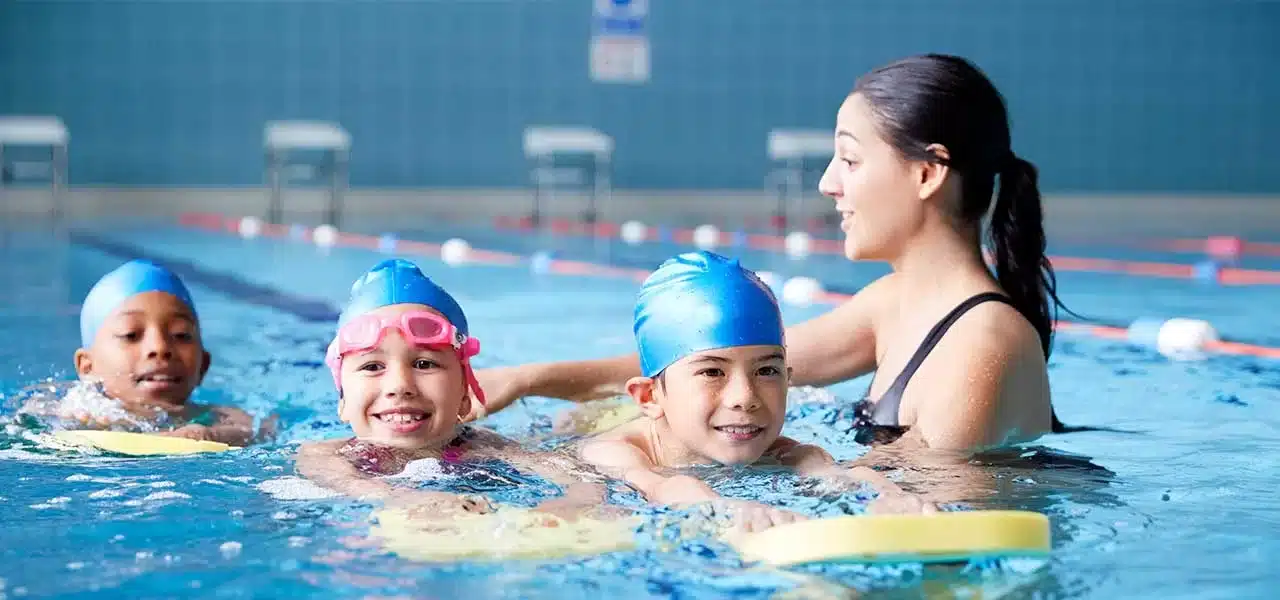
Swim Lesson Plans
Learning how to swim is one of life’s most valuable skills, and not only for the benefit of water safety. When you teach a child how to swim, it opens the door to one of the most enjoyable forms of recreation and fitness. But most importantly, learning to swim can also save a child’s life. In this article, we go over safety tips, swim skills, and some swim lesson plans for fitness. Let's dive in!
Why Learning to Swim is So Important
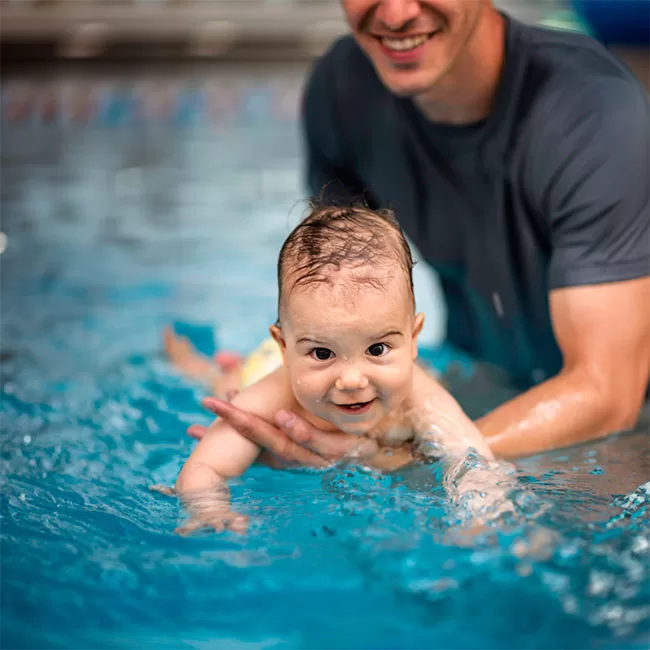
According to the CDC, every day in the U.S., an average of two children succumb to drowning, and another 10 are admitted to hospitals in near-drowning incidents. Drowning is the leading cause of accidental death for children aged 1-4, and the second leading cause of death for kids age 1-14.
Drowning is a horrible tragedy, but one that’s avoidable, in most cases. In the words of Olympic swimmer Cullen Jones “Drowning is preventable; two words – swim lessons.” However, for small children under 5 years old, complete proficiency is unlikely and should be supplemented with layers of protection around the pool, including four-sided fences, pool alarms and safety covers.
Teaching kids to swim is one of the most important parental responsibilities, just as important as teaching your child to look both ways before crossing the street. As of 2010, 15 European countries had made swim lessons a compulsory part of school curriculum, as reported by the New York Times. Not so in the United States, where learning to swim is optional.
Swim Lesson Planning & Preparation
Teaching kids how to swim requires only a few instruments, first and foremost being a swimming pool. Teaching your child how to swim could be more fun in groups. As you make your annual/seasonal swim lesson plans, spread the word to other parents who may like to join.
For Swim Students:
- Swimsuit. Take them shopping for their new swimsuit each year, and instruct them never to go swimming without wearing a swimsuit. Teach that swimming in clothes and shoes is unsafe.
- Sunscreen. Protect their skin while they are in the pool or on the pool deck. A tight fitting swim shirt or large hat can also be used to protect the skin from too much sun.
- Kickboard. For use when learning simple strokes and for kicking exercises, a foam kickboard (not inflatable) can be used in multiple ways during a swim lesson.
- Swim Diaper. For those not yet potty trained, a swim diaper is worn over a regular diaper.
- Good Health. Delay the lesson if your child has an illness or needs a nap.
- Towel. And dry clothing to change into after the lesson is over.
For Swim Teachers:
- Swimming Pool. Learning to swim in lakes, streams and oceans can be unsafe due to deep mud, currents and riptides. A shallow wading pool or baby pool is the best place to start, if available. Otherwise, use the shallow end of a pool, preferably with walk-in steps. Aboveground pools or large spas can also be used for teaching toddlers to acclimate to water and learn basic swim skills.
- Swimsuit. Set the example of never swimming without a swimsuit. Can wear a hat but no sunglasses.
- Enthusiasm. Bring a big smile and a big heart to each swim lesson, with some patience and empathy, too!
- Swim Lesson Plans. Use a binder that you can stand up and with plastic sheet holders to hold your lesson plan on the edge of the pool. Print our swim lesson plans.
- Schedule. Just like other important things, schedule swim lessons for a solid time slot on your calendar. Hold them once or twice per week; for 8-12 weeks could be appropriate.
- Pool Noodle. Can be used to provide you added buoyancy, or for kicking and floating drills.
Swim Lesson Tips:
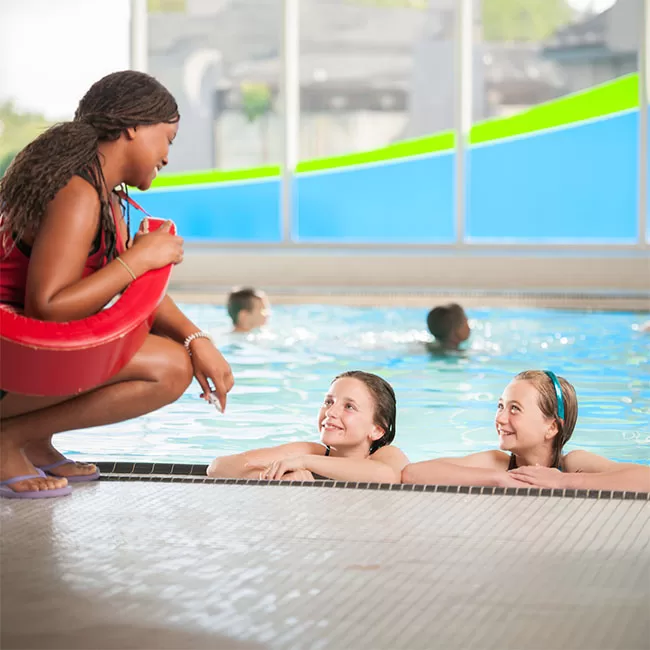
- Each swim lesson for infants and toddlers should last only 15 minutes; up to 30 minutes for 3- to 5-year-olds, and up to 45 minutes for children over 5 years old.
- The ratio of swim teacher to swim student should be 1:1 for children under 5 who have not reached swim stroke and treading water proficiency.
- Slow and steady. There is no time limit on progressing from one swim level to the next. Some children will take longer on certain levels, and swim lessons may need to repeated, perhaps several times, until the swim student can confidently progress to the next level. Stay positive and encourage the swim student toward short-term objectives and long-term goals.
- Maintain arm’s length distance at all times during swim lessons and constant focus on the swim student. Don’t allow any distractions whenever a child is around the pool.
- A temperature of 82 degrees or warmer is most suitable for teaching kids how to swim. Colder pool water will detract from their ability to learn to swim.
- Using a USCG-approved foam life vest may be helpful at other times, but not during the swim lesson. Likewise, don’t use water wings, or "swimmies," because they interfere with proper swim movements and allow for bad stroke development. Using floatation devices will underutilize key muscle groups needed for swimming and could also provide a false sense of security.
- Feed your swim student 1 hour before the lesson and give fluids after the lesson.
Swim College: Ability-Based Swim Lesson Plans
SWIM COLLEGE curriculum is not based on age, but rather on ability. No matter if infant, toddler, preschool age or much older, the same basic progression is used. In the early years, you may need to repeat previous swim lesson plans as a refresher, and to re-acclimate to the water.
SWIM COLLEGE is arranged as a four-year curriculum, but students are encouraged to do post-graduate work and continue studying each summer for a total of six-plus years. Swim students can begin at any age, as early 12-24 months, although swim strokes don't usually develop until 4 or 5 years of age. Plan each season’s swim lessons for 8-12 weeks, once or twice per week.
For teaching toddlers how to swim, parents may consider professional swim instruction by a qualified instructor, when available. Most municipal and school pools offer swim classes for kids, or you can search for a local swim instructor at a community pool or online on community message boards.
Begin each swim lesson with some safety training and give reminders and praise for the safe swimmer throughout a lesson. Spend as much time as is needed on each section before moving into more advanced skills. Some swimming skills will take longer than others – be patient and encouraging toward small objectives and larger goals.
And finally, have fun, and let your students have fun too.
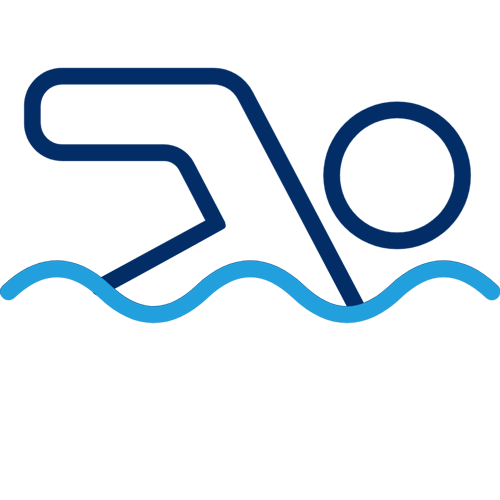
Swimming 101:
Safety Rules
Every swim lesson should have a pool safety component. In the early years, pool safety should focus on definitive rules such as no swimming alone, no swimming without a bathing suit, and stay in the shallow end. As a young swimmer develops greater awareness, more advanced pool safety education should be taught and reviewed annually.
Acclimation
Don’t rush this step; even a small pool can seem intimidating to a young child. Standing in the shallow end, have the swim student sit on the edge of the pool, or on the pool steps, with their feet in the water and start with a little splashing to get used to the temperature. Pull them up close to your chest when they are ready and hold them closely while smiling and having fun, moving into the shallow end. Gently dip your body lower until the water is up to the child’s shoulders, bouncing up and down with a reassuring smile. Using pool floats to rest the child on while you stand and holding your student are helpful at many stages during beginning lessons.
Submersions
Proceed deliberately slow; this can take several lessons to perfect. Gradually dip lower in the water, looking and smiling at your student until you can get up to their chin. Slowly dip both of your mouths below surface and blow bubbles just under the surface. Once you’ve mastered the blowing bubbles by mouth, the next milestone is going over the nose, eventually dipping fully underwater and looking at each other without blowing bubbles, holding your breath for 1-2 seconds. Taking an exaggerated breath or blowing in babies face can cue them to hold their breath.
Kicking
Hold your child in front of you and help them to begin kicking their feet, showing them a slow and steady underwater kick. Using a foam pool float or large kickboard can be helpful for kicking exercises to help support the student comfortably. Practice front kicking and back kicking until they can do it on cue; it’s one of the most important skills of swimming.
Back Float
Use both hands to support your student’s head and body while back floating and breathing. Stand behind them and try to encourage eye contact to help keep your student's head down and eyes back. A song or gentle rocking can help to calm anxiety. Float for 30-60 seconds, or until your student becomes fussy, gradually reducing your hand support.
Front Float
Use both hands to support your student’s arms while front floating. Start with head-up front floating, supporting your student. Work up to face-in-the-water front floating, which can take some time to master. It may help if you can sit on the floor with your student floating on the surface, within arm’s reach. A snorkel and mask can be used for older students.
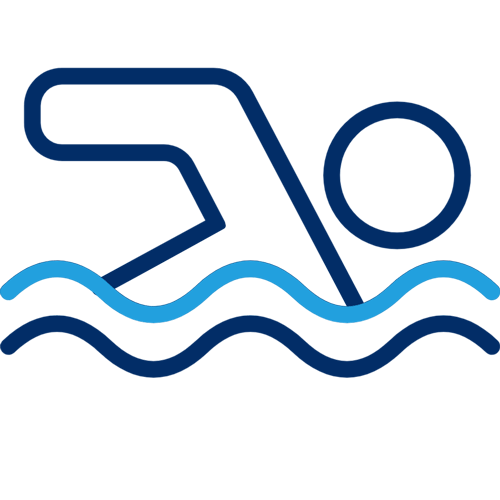
Swimming 201:
Safety Rules
Review previous swim safety rules such as never swimming alone or without a swimsuit and staying in the shallow end. Jumping in safely means feet first, in shallow water, where you can see the bottom. Diving head first is never safe and should be reserved for competitive swimmers. Practice the skill of getting to the edge of the pool from a short distance away.
Breath Control
A sophomore swimmer is not very coordinated with breathing around water; they may inhale somewater and cough. When this happens, respond with smiles and encouragement and resume when they regain their composure. Separatey practice blowing bubbles and breath holding under water. Practice breathing while back floating and front floating with support.
Rolling
This has reminded me of a dog trick, but being able to roll over, from back to front and vice-versa, is an important early skill. Start with a supported and comfortable back float, and help your student to turn right by throwing right the left arm and pushing the left elbow back. Start with these mechanics and gently ease into the skill of rolling from a back float to a front float, with support, and the reverse, rolling from front to back. The student should be able to roll themselves easily, with breath control.
Kicking
Practice a flutter kick in several ways during each lesson to build the muscle memory of a movement, which is actually quite complicated. In more advanced swim students, the swim kick develops to use the entire lower half of the body, the hips, knees, ankles and toes. For now we are splashing water, motor boating, and kicking rhythmically. Use a pool float or kickboard for student support while you give some assistance.
Jumping In
Jumping off the side of the pool’s shallow end and into your waiting arms is both fun and scary for a young swimmer. You can start from a seated position if needed, and work your way up to jumping in toward you, submerging and resurfacing to your waiting arms. Teach them to jump out into the pool, away from the wall. You can practice on land and show them how far they can jump.
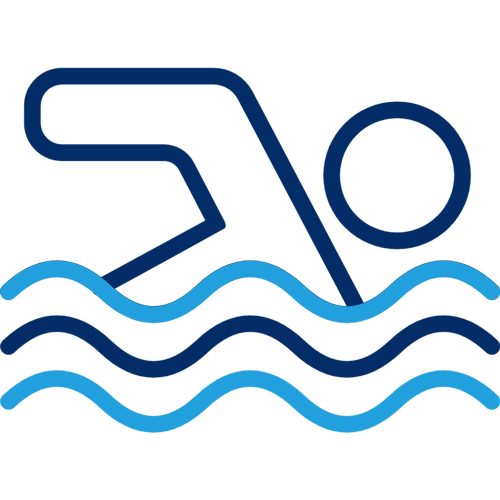
Swimming 301:
Safety Rules
Continue the skills of swimming short distances to the side, steps or ladder. Practice the skills of touching bottom and pushing off the pool floor to resurface. Discuss pool barriers, fencing, gates, doors, and how they can protect non-swimming people and animals.
Breath Control
Continue to practice front floating and back floating breathing exercises, and practice rolling and dipping while holding breath. Gradually increase the time underwater, but to no more than a few seconds. If the child is over 3 and they like to jump, go into water just deeper than their head and practice bouncing off the bottom and springing up above the water.
Dog Paddle
It’s very exciting when your student begins to paddle short distances. To start you can provide a little lift to their swimsuit or support under their belly. Perfecting the doggy paddle means slowing it down, taking deeper strokes and using a longer kick stride for a less tiring stroke.
Back Sculling
Floating on their back, teach your student to use their hands and wrists like fins to paddle slowly (sculling) and help stay afloat easier. Add in some arm motion and the arms can be used like boat oars to move more water. Add a back kick for faster propulsion, encouraging and demonstrating a proper back flutter kick.
Dive and Rise
With the student on the edge of the shallow end wall or on the pool steps, have them push off underwater, extended like Superman, and glide to your waiting arms 4-6 feet away. Add in a front breast stroke pull if possible.
Treading Water
As they gain more comfort and skills in the water, you can assist them with treading water skills by giving light support and helping them to coordinate their arms and legs to keep them afloat while using the least amount of energy.

Swimming 401:
Safety Awareness
Review the rules of the pool such as no swimming alone (If adult must leave, you must leave.), and no swimming without a swimsuit. No diving. No running. No horseplay. No glass. Keep the gate shut. Give your child a small responsibility for pool safety around your home pool, telling him or her how important their help is in making the pool safe Give praise for positive safety behaviors.
Straight Kick
This is advanced kicking, working on the involvement of the entire leg A true "flutter kick" motion, and is below the surface of the water, with fluidity and full leg coordination. We constantly work on kick improvements throughout Swim College, until it becomes automatic, or something the swimmer doesn’t have to think about.
Backstroke Kick
The backstroke kick appears to be a mirror image of the front kick, but in fact there are small differences in the stride and rhythm of kicking while back floating. Different muscle groups are also used. Give the backstroke kick as much practice time as the straight kick. Playing slow rhythmic music can be used to help establish a tempo.
Freestyle Breathing
As a precursor to freestyle stroke, teach the method on dry land first, using a short bench to lay your student upon. Dry land videos of swimmers in slow motion could also be used demonstrate the motion in action. Demonstrate and practice in the pool with light support for your swimmer. Practice for several sessions, with support and without kicking, until the motion of turning the head to breathe in coordination with the opposite hand thrust, becomes nearly natural.
Freestyle Stroke
Bringing together three skills – kicking, pulling and breathing – freestyle stroke is what separates the non-swimmer from the swimmer, when they continue beyond basic stroke development. For many children, this may not come until ages 5 or 6, even for those with advanced motor skills. Take it slow and stick with it – and always end your swim lessons on a positive note.
Advanced Treading Water
Now we enter survival swim training territory. Review the basics of treading water with hands and arms sculling and legs doing a modified bicycle kick. Practice rhythmic breathing while treading water until your swim student can tread water for 30-60 seconds, with you within arm’s reach.

Graduate School:
Water Rescue Basics
Review the rules. Praise your student (gold star!) when they show safe water behavior (entering/exiting safely, shutting a gate or door, or leaving the pool with you if you have to run inside the house). If appropriate for your child, instruct on what 911 is and when it may be appropriate to dial 911 for water rescue. Young children should be taught to find an adult for any kind of small or large emergency at the pool. If appropriate for your child, CPR demonstration and discussions can be held – no giggling!
Backstroke Basics
The backstroke begins with a good back float and a solid back kick. Add to it a head-back shoulder rotation windmill motion, scooping lots of water on your down stroke. Breathe rhythmically with the stroke and really stretch out long to bring kicking, stroking and breathing together.
Eggbeater Kick
This is the kick used by water polo players to lift them out of water to their waists. A very powerful kick, but at much slower rates, it’s an easy way to tread water and conserve energy. Each leg moves in opposite rotation to the other, so that the upper leg is pumping up and down while the lower leg is swirling in a circular rotation from the knee to ankle.
Breaststroke Kick
The eggbeater kick has been said to be a modified breast stroke kick, which is also known as the frog kick, where the legs are drawn up and then squeezed together while being thrust out to full length. Practice kicking while holding onto and facing the wall or a large float. Small kickboards can be used for further training. Dry land bench training or videos can also be used, along with demonstrations.
Breaststroke Basics
Pushing off the wall and gliding, like Superman, is a good place to start. The motion of the stroke used in breast stroke is a hard one for younger kids and will take some practice. I think of the stroke motion as an upside-down heart. Pull down from the top, then join hands below your chest and bring the arms back up the middle. Keep the torso flat, (no rotation) and bob up for air as you bring your arms back close the chest.
Advanced Freestyle
Picking up on what was learned in earlier lessons, the stroke mechanics of the freestyle or crawl can be fine-tuned for both distance and endurance. Stronger breathing skills, more powerful strokes and less turbulent kicking are the objectives.

Doctoral Studies:
Advanced Water Safety
Review the pool rules. Topics include layers of protection and the shared responsibility of keeping gates and doors locked to protect animals and people that can’t swim from drowning dangers. Review of water rescue basics (call an adult). Shallow water blackout danger from hyperventilation should be discussed with your swim students.
Advanced Breaststroke
Fine-tune the mechanics of breast stroke to increase distance and endurance. A simple proficiency can be quickly gained, but greater coordination between the kick and stroke comes with practice.
Advanced Backstroke
Same as above, additional stroke practice is necessary – even though a student may already understand the basic stroke mechanics, added practice always improves muscle memory and stroke development.
Advanced Breath Control
When you let out all of your air, you’ll sink slowly to the bottom. Practice this in shallow water, rapidly exhaling a big breath to sit on the pool floor. Tea party time! Another breath holding exercise is gliding from the wall with a breast stroke kick. Exhaling while sinking to the shallow end floor and pushing off the floor to a big breath above water.
Deep Water Diver
Is your swim student ready for the deep end? If they can swim across the deep end, they should be able to dive down into the deep end, holding your hand or having you within arm’s reach. Practice letting out chest air to dive into deeper water, then push off the bottom to resurface rapidly. If you have a diving board available, you can practice proper dive technique or teach diving safely from the edge into deep water.
Butterfly Stroke
For those that want to learn all of the major swimming strokes, even more than improving upon the other three, we have the butterfly stroke. Start with learning the butterfly kick, also known as the dolphin kick. Add the stroke by moving both arms simultaneously over the shoulders and pulling hard through the water while coming up for air. The butterfly stroke is arguably the most difficult coordinated movements in swimming, requiring practice to reach a basic stroke proficiency.
Recommended Resources
Please consult other online resources for more in-depth information regarding teaching young children how to swim. Swimkids, is another great Australian resource for teaching kids how to swim. Swimming.org is a British site with very good learn to swim information using the ASA Foundation Framework. Before teaching your kids how to swim, download and read the Red Cross swimming and water safety manual.
Conclusion
Swimming lessons should be a part of every summer season. Make it a priority to have at least 8-12 weeks of progressive swim lessons every year. Begin early and continue annual swim training for up to 10 years, for best results.
Teaching kids to swim is not easy, but it's important. If you have a pool in the backyard, it could be the most critical skill that your child learns, for their own safety around water and your own peace of mind.